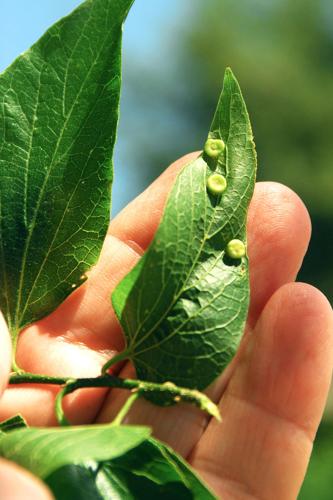Dear Neil: What are the pimple-like growths on the leaves of my hackberry tree? Are they harmful?
Those are insect galls that result when the female insect stings the leaves of the tree and lays her eggs. The plant tissue forms around the developing larvae. Eventually they will emerge, fly, mate, and start the process over again. They do no harm to the tree and itĐÔĘӽ紫ý™s not possible to prevent or control them. TheyĐÔĘӽ紫ý™ve been with hackberries since Day 1.
Dear Neil: We have just bought a house that is going to need some repairs. The lawn is among them. It is bermudagrass, but weĐÔĘӽ紫ý™d like to switch it to St. Augustine. Our budget is tight. If we use plugs, how far apart can they be planted and how long will it take for them to cover? When should we do that?
Distance and time work in inverse order. I would recommend using plugs that are somewhere around 5 inches square and spacing them checkerboard-style about 16 inches apart. I use a flat-bladed nursery spade (also called a tile spade) to cut pieces of sod into the squares. I use the same spade to cut shallow holes to accept the plugs. I have a wheelbarrow alongside for the soil from the holes. You can use the loose soil to fill in around the plugs. Water them by hand morning and evening for their first week, then once a day for a week. By then they should be well rooted and ready to go. Mow at 2 inches and the St. Augustine should be fully covered by the end of next summer.
Dear Neil: I have several large Boston fern pots. IĐÔĘӽ紫ý™d like to start several more for my greenhouse, specifically hanging baskets. Can I raise them from the spores I see forming on their leaves?
Assuredly you could. That is, after all, the way nature does it on her own. However, it would be immensely easier and a lot faster if you were just to take one of your pots, water it thoroughly, and divide it into many tennis-ball-sized clumps. Pot them up individually into 1-gallon pots for a couple of months, then repot them into the hanging baskets. They should make handsome baskets by spring. Grow them in bright light but out of direct sunlight and keep them well-nourished with a water-soluble high-nitrogen food.
Dear Neil: What is the best way to nurse my tomato plants through the summer so I can get a fall crop?
ThatĐÔĘӽ紫ý™s difficult, perhaps almost impossible. Spider mites and the impact of 10 weeks of incredible heat take a terrible toll on the plants. If you insist, you could trim them back by 30 or 40 percent, fertilize and water them regularly. However, youĐÔĘӽ紫ý™d be much farther ahead if you were to plant young, vigorous transplants from the nursery or feed store. Choose small or mid-sized varieties since theyĐÔĘӽ紫ý™re better able to set fruit in fallĐÔĘӽ紫ý™s cooler weather. Protect the new transplants from afternoon sun for a few days until they can become acclimated to their new surroundings. They need to be planted as soon as possible to give maximum yields before the first killing freeze in the fall. I know that sounds implausible but do the math figuring back for the area and youĐÔĘӽ紫ý™ll see what I mean.
Dear Neil: I have a new Shumard red oak that we planted in April. The edges of its leaves are brown. Could that be oak wilt already? What else would have caused it?
ItĐÔĘӽ紫ý™s not oak wilt. IĐÔĘӽ紫ý™d be willing to guarantee that the tree has gotten too dry one or more times since it was planted. It was grown in a very porous, lightweight potting soil to save on labor and transportation costs. The tips and ends of leaves are the last places to receive water and the first places to dry out when soil begins to dry. Often, itĐÔĘӽ紫ý™s because people are using drip irrigation or sprinklers to water new shrubs and trees. Newly planted landscape plants should be watered by hand for their first year in our gardens. They should be given the same amount of water as their original pots on 2-day intervals when temperatures approach 100F. In other words, plants that were sold in 7-gallon containers would get 7 gallons, 15-gallon pots would get 15 gallons, etc. A water bubbler on the end of your garden hose will make quick work of that task.
In fairness, other things can contribute to those symptoms. They would include too much fertilizer or trunk damage due to insects or injury (or, after a couple of years, sunscald). Whatever the cause, though, it has resulted in moisture stress to the leaves. By the way, be sure to apply paper tree wrap to the trunk of your new tree for its first two years to prevent sunscald. Hopefully youĐÔĘӽ紫ý™re not too late already.
Dear Neil: Why are so many of my rose-of-SharonĐÔĘӽ紫ý™s flower buds on the ground, never having opened?
Again, it boils down to high temperatures and insufficient water moving through the plant. Althaeas produce their buds during the spring (late April through May and into June) when conditions are reasonably cool and usually moist. Then the blast furnace opens and the plants canĐÔĘӽ紫ý™t keep up with the demands for water. Their reaction is to drop a sizable percentage of their buds. They abort without warning. Your best defense as that begins is to soak their soil deeply. Repeat every 5-7 days.












